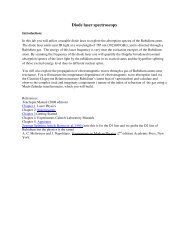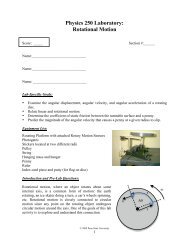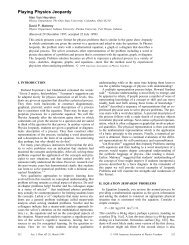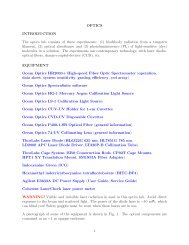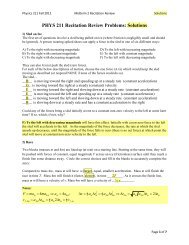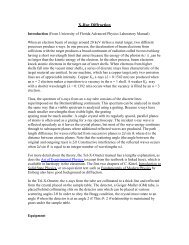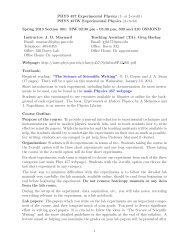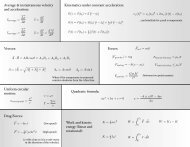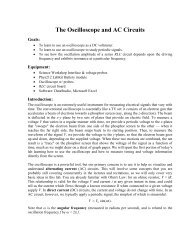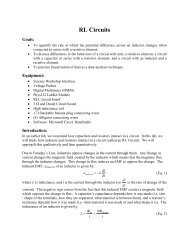Faraday's Law, Inductance, and RL Circuits
Faraday's Law, Inductance, and RL Circuits
Faraday's Law, Inductance, and RL Circuits
Create successful ePaper yourself
Turn your PDF publications into a flip-book with our unique Google optimized e-Paper software.
Faraday’s <strong>Law</strong>, <strong>Inductance</strong>, <strong>and</strong> <strong>RL</strong> <strong>Circuits</strong><br />
NAME:<br />
NAME:<br />
NAME:<br />
RECITATION SECTION:<br />
INSTRUCTOR:<br />
DATE:<br />
____________________________________<br />
____________________________________<br />
____________________________________<br />
__________________________<br />
__________________________<br />
__________________________<br />
This activity is based on the following concepts:<br />
<strong>Faraday's</strong> <strong>Law</strong> of Induction: If the magnetic flux Φ B through a closed loop C changes<br />
with time, an induced electric field E is created. The rate of change of the magnetic flux<br />
<strong>and</strong> the electric field are related by:<br />
d<br />
B<br />
E ds<br />
dt<br />
C<br />
Self-induction: If a current i is a coil changes with time, an emf is induced in the coil.<br />
o This self-induced emf is<br />
di<br />
L<br />
L ,<br />
dt<br />
where L is the inductance of the coil (inductor).<br />
o <strong>Inductance</strong> is measured in units of henries (H)<br />
Rules of thumb for <strong>RL</strong> circuits:<br />
o When you make a change in an <strong>RL</strong> circuit, initially, an inductor acts to oppose the<br />
change in current. A long time later, it acts like an ordinary piece of wire.<br />
o <strong>Circuits</strong> with inductors resist any changes in current; so, if you throw a switch, the<br />
current through an inductor cannot change instantaneously (unless, of course, you<br />
break the circuit…)<br />
The current in a series <strong>RL</strong> circuit is<br />
t<br />
L<br />
Rise of Current i ( 1 e )<br />
R<br />
Decay of Current t<br />
L<br />
i i0<br />
e<br />
o In questions Q5 – Q7, the circuit is not a series <strong>RL</strong> circuit
Exercise 1:<br />
The figure below shows the cross-sectional view of an ideal solenoid with n turns per unit length<br />
<strong>and</strong> a radius R 1 . At some instant in time, the current through the coil is increasing at a rate di/dt<br />
<strong>and</strong> the instantaneous value of the current is i going clockwise as viewed in this picture. A point<br />
charge +Q is located as shown at a distance R 2 from the axis of the solenoid.<br />
i<br />
+Q<br />
R 1<br />
R 2<br />
Your aim is to use Faraday’s <strong>Law</strong> to determine the instantaneous force experienced by the<br />
charge Q. The following steps are meant to help you work through the necessary reasoning.<br />
Q1. First, determine the instantaneous magnetic field B(r) created by the solenoid. (Note: you<br />
may use Ampere’s <strong>Law</strong> to derive this, or refer to the result derived in your textbook or lecture<br />
notes). Be sure to write explicitly: what is the magnitude <strong>and</strong> direction of B(r) for r < R 1 ? what<br />
about r > R 1 ?<br />
Q2. Next, imagine a circular path of radius R 2 concentric with the solenoid <strong>and</strong> determine the<br />
instantaneous magnetic flux through the area enclosed by this circle. From this, then determine<br />
the instantaneous rate of change of magnetic flux through this area with time.
As was described in the introduction, Faraday’s <strong>Law</strong> connects the rate of change of the magnetic<br />
flux through a closed loop (which you just found) to the integral of the electric field around that<br />
loop. If you look at the figure again, you’ll notice that (aside from the charge +Q outside the<br />
solenoid), the entire situation looks exactly the same if you rotate the figure about the center of<br />
the solenoid. We say, then, that the problem is rotationally symmetric. We can use this symmetry<br />
to argue that (i) the electric field induced by the changing current in the solenoid must be<br />
oriented tangent to any circular path concentric with the solenoid <strong>and</strong> (ii) the component of the<br />
electric field along our imaginary circular path must be constant all along that circle.<br />
Q3. So, now that we know that the induced electric field must be tangent to our imaginary circle<br />
of radius R 2 , in which sense is the electric field oriented: clockwise or counter-clockwise? One<br />
way to answer this is to consider what would happen if there were an actual conducting wire<br />
placed along our imaginary loop. Use Lenz’ law to figure out the direction of the current that<br />
would be induced if you did this, <strong>and</strong> from this, determine the direction of the electric field.<br />
Q4. Given that the magnitude of the electric field must be the same at every point along this<br />
imaginary loop, use the results you have obtained so far to finally determine the instantaneous<br />
force on the point charge Q.
Exercise 2:<br />
In the circuit shown adjacent, V = 60.0 V, R 1 = 10.0 Ω, R 2 = 20.0 Ω, <strong>and</strong> L = 3 H.<br />
Q5. Immediately after the switch is closed, what<br />
is the value of the current through R 2 ? Make<br />
sure you justify your answer.<br />
R 1<br />
R 2 L<br />
V<br />
+<br />
−<br />
Q6. Immediately after the switch is closed, what is the rate of change of current through L? Also,<br />
specify the direction (up/down) that the current flows through L. Justify your answer.<br />
Q7. A long time after the switch is closed, what is the value of the current through R 2 ? Justify<br />
your answer.<br />
Q8. Once the circuit has reached a steady state (a long time after the switch was initially closed),<br />
the switch is reopened. Immediately after the switch is reopened, what is the value of the current<br />
through R 2 ? After the switch is reopened, how much time does it take for the current in R 2 to<br />
reach approximately 37% of its initial value? Justify your answers.



